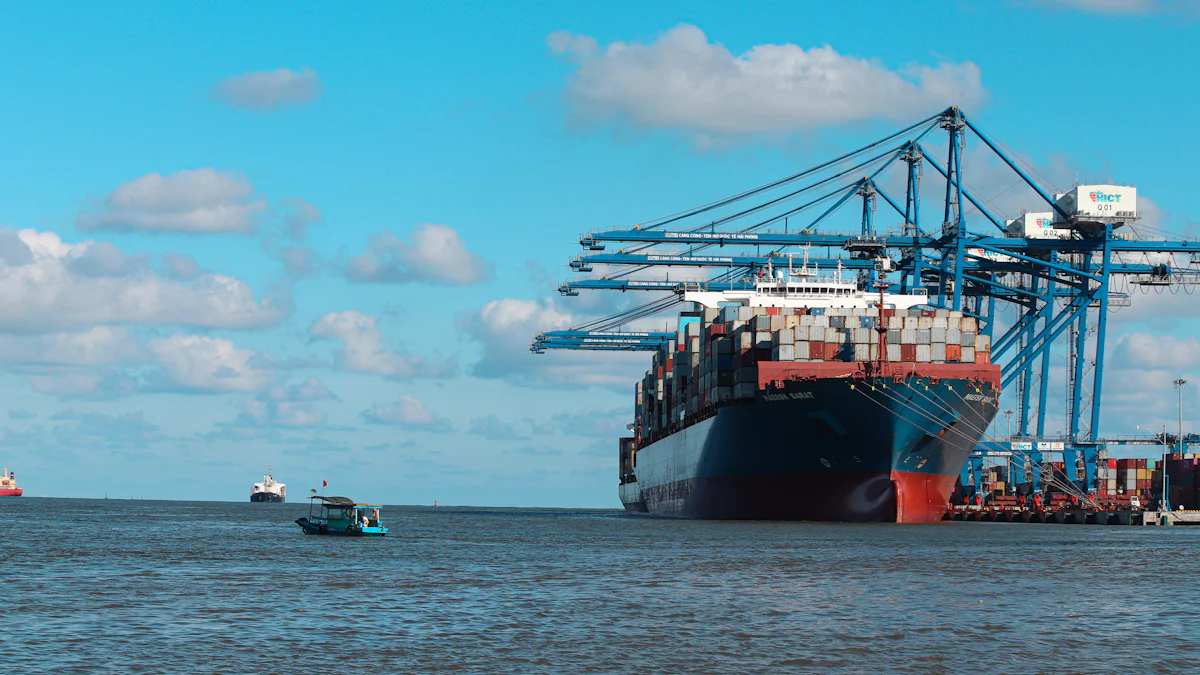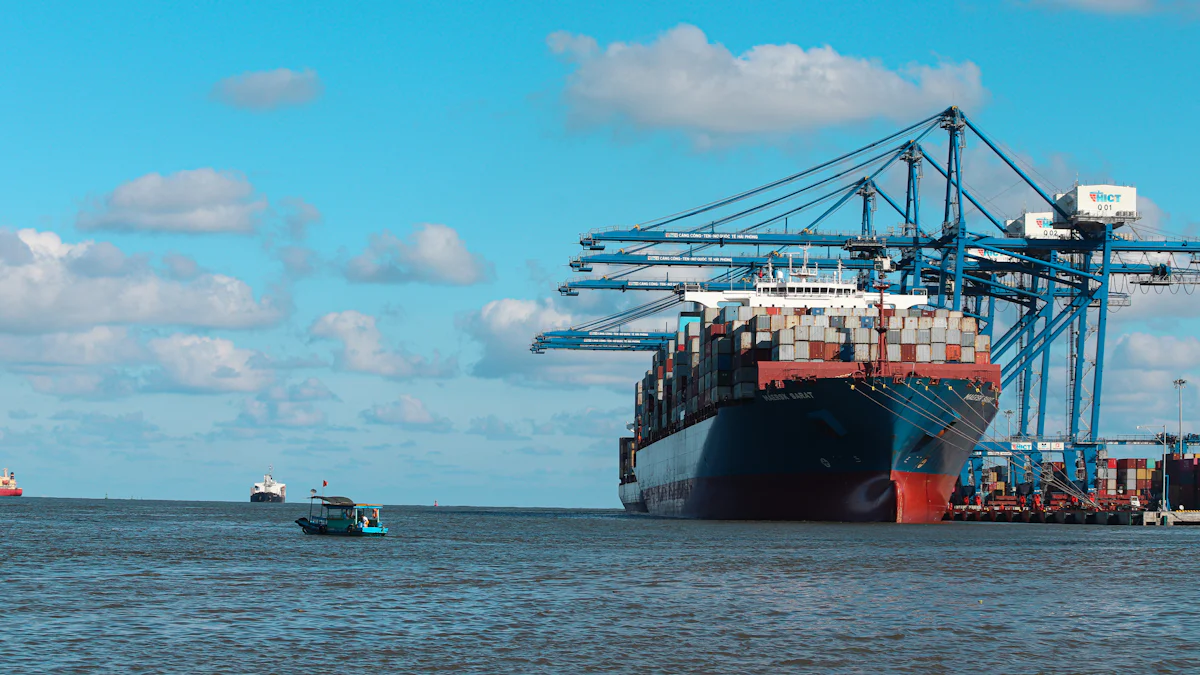Market Dynamics of Ocean Freight: What the Future Holds

Ocean freight plays a crucial role in global trade, facilitating the efficient movement of goods across continents. This mode of transport supports production, trade, and consumption activities by ensuring the availability of essential components for manufacturers and consumers. Understanding the Market Dynamics of ocean freight is vital for anticipating future trends and making informed decisions. The sector's significance is underscored by its substantial contribution to international trade volumes and its impact on sustainability practices.
Current State of the Ocean Freight Market

Economic Factors
Global Trade Patterns
Global trade patterns have evolved significantly since World War II. Annual real global trade has grown faster than GDP, averaging 1.5 times the rate of economic growth. Reductions in barriers to international exchange, such as tariffs and quotas, have contributed to this growth. These reductions have led to higher income levels, lower prices, and greater consumer choice.
However, the introduction of tariffs can disrupt these patterns. For instance, the U.S.-China tariff hikes in 2018-19 affected global trade patterns. These tariffs did not reduce trade but reallocated it. Other countries continued to pursue regional or plurilateral trade agreements despite the bilateral tariffs.
Impact of Tariffs and Trade Wars
Tariffs can divert resources from efficient economic activities to less efficient ones. This diversion results in higher prices and reduced employment. Studies show that tariffs often fail to achieve their objectives and can lead to negative economic consequences. The U.S. maintains duties against several categories of goods with varying tariff rates. These tariffs can impact global trade by increasing costs and reducing the competitiveness of affected goods.
Between 1995 and 2020, international trade costs decreased by approximately 6 to 10 percent. This decrease led to a notable increase in global trade. Eliminating remaining trade barriers could result in significant gains, with estimates ranging from $250 billion to $680 billion per year. Developing countries would gain more from global trade liberalization as a percentage of their GDP than industrial countries.
Technological Advancements
Automation and Digitalization
Automation and digitalization are transforming the ocean freight industry. Automated systems enhance efficiency by reducing manual labor and minimizing human error. Digital platforms streamline operations, enabling better tracking and management of shipments. These advancements improve supply chain visibility and optimize logistics processes.
The integration of AI with big data processing capabilities revolutionizes supply chain management. AI can process massive amounts of data in real-time, enabling more accurate predictions of production and sales trends. This optimization reduces decision-making risks and enhances a company's competitive edge in the market.
Blockchain Technology
Blockchain technology offers significant potential for the ocean freight industry. This technology provides a secure and transparent way to record transactions. Blockchain can enhance trust and reduce fraud by providing an immutable record of shipment details. This transparency improves efficiency and reduces disputes between parties.
The collaboration between Zunshi and the Supply Chain Innovation Institute of Ningbo has led to the development of the "Maritime Dynamic ETA Algorithm." This AI-driven model predicts port arrival times, weather impacts, and shipping risks. Such advancements improve early warning systems for anomalies in multimodal transport and enhance the efficiency of international maritime shipping.
Market Dynamics
Supply and Demand Trends
Supply and demand trends play a crucial role in the ocean freight market. Economic growth drives demand for goods, leading to increased shipping volumes. However, market dynamics can shift due to various factors, including geopolitical events and changes in consumer behavior. Companies must monitor these trends to adapt their strategies accordingly.
Shipping disruptions underline the vulnerability of global trade to route chokepoints. These disruptions can limit the visibility of shipping costs and affect supply chain reliability. The container ship order book in late 2020 and 2021 did not show general concerns about near future over-supply among market agents. This indicates a balanced approach to managing capacity and demand.
Pricing Strategies
Pricing strategies in the ocean freight market depend on various factors, including fuel costs, port fees, and market demand. Companies must adopt flexible pricing strategies to remain competitive. Cost management and procurement practices help ensure stable and competitive pricing services. Consolidating cargo volumes and collective procurement can manage costs effectively, especially during peak and off-peak seasons.
Tailored offerings for different markets, such as automotive components and renewable energy products, meet diverse market demands. Enhancing ground handling capabilities at gateway airports and improving door-to-door services abroad are crucial for maintaining competitive service levels. Customized services for specific markets, such as India, Southeast Asia, Europe, and the US-Mexico corridor, cater to unique market needs.
Key Challenges Facing the Industry
Environmental Regulations
IMO 2020 Sulfur Cap
The IMO 2020 Sulfur Cap mandates a maximum sulfur content of 0.5% in marine fuels globally. This regulation aims to reduce sulfur oxide emissions, which contribute to air pollution and harm human health. Shipowners and operators must make significant decisions to comply with these requirements. Options include using compliant low-sulfur fuels or alternative fuels such as LNG, LPG, CNG, biofuel, solar power, or fuel cells. Vessels equipped with exhaust gas cleaning systems can still use high-sulfur fuel oil.
Carbon Emission Targets
Carbon emission targets present another challenge for the ocean freight industry. Governments worldwide are implementing stricter regulations to reduce greenhouse gas emissions. The industry must adopt cleaner technologies and practices to meet these targets. Companies are investing in energy-efficient ships and exploring renewable energy sources. The shift towards sustainability requires substantial financial investment and operational changes.
Geopolitical Risks
Political Instability
Political instability poses a significant risk to the ocean freight market. Conflicts and political unrest can disrupt shipping routes and affect global trade. Companies must monitor geopolitical developments to mitigate risks. Diversifying shipping routes and establishing contingency plans can help manage the impact of political instability on supply chains.
Trade Policies
Trade policies also influence the dynamics of the ocean freight market. Changes in trade agreements and tariffs can alter shipping patterns and costs. For example, the U.S.-China tariff hikes in 2018-19 affected global trade patterns by reallocating trade flows. Companies need to stay informed about trade policy changes and adjust their strategies accordingly. Understanding the implications of trade policies helps businesses navigate the complexities of international trade.
Infrastructure and Capacity Issues
Port Congestion
Port congestion remains a persistent issue in the ocean freight industry. High volumes of cargo can overwhelm port facilities, leading to delays and increased costs. Efficient port management and infrastructure development are crucial to addressing congestion. Investments in port expansion and modernization can enhance capacity and improve the flow of goods. Advanced technologies, such as automated systems and digital platforms, can also streamline port operations.
Fleet Management
Effective fleet management is essential for maintaining operational efficiency in the ocean freight market. Companies must balance fleet size with market demand to avoid overcapacity or shortages. Regular maintenance and upgrades ensure that vessels remain in optimal condition. Strategic fleet deployment can help companies respond to changing market dynamics and customer needs. Adopting innovative technologies, such as AI and IoT, can enhance fleet management practices and improve overall performance.
Future Trends and Predictions

Technological Innovations
Autonomous Ships
Autonomous ships represent a significant leap forward in maritime technology. These vessels operate with minimal human intervention, relying on advanced sensors, AI, and machine learning algorithms. Autonomous ships enhance efficiency by reducing human error and optimizing routes. The implementation of autonomous ships can lead to fewer accidents and lower operational costs.
Case Study: Autonomous Machines for Efficient Ports
Autonomous ports require less space.
Reduced idling of ships.
Minimal human-machine interactions.
The integration of autonomous ships with smart ports can revolutionize the ocean freight industry. This synergy will streamline operations and improve overall logistics efficiency.
Internet of Things (IoT)
The Internet of Things (IoT) plays a crucial role in modernizing the ocean freight sector. IoT devices provide real-time data on various aspects of shipping, including cargo conditions, vessel performance, and environmental factors. This data allows for better decision-making and enhances supply chain visibility.
IoT technology enables predictive maintenance for ships, reducing downtime and extending the lifespan of vessels. Companies can monitor fuel consumption and optimize routes to reduce emissions and costs. The use of IoT in ocean freight supports sustainability practices and improves operational efficiency.
Market Growth Projections
Emerging Markets
Emerging markets present significant opportunities for growth in the ocean freight industry. Countries in Asia, Africa, and Latin America are experiencing rapid economic development. This growth drives demand for goods and increases shipping volumes. Companies must focus on these regions to capitalize on new business opportunities.
Investments in port infrastructure and logistics networks in emerging markets will facilitate trade and improve market access. Companies should establish strong partnerships with local entities to navigate regulatory environments and cultural differences.
Investment Opportunities
Investment in technology and infrastructure will shape the future of ocean freight. Companies must allocate resources to develop and implement innovative solutions. Areas such as autonomous ships, IoT, and blockchain technology offer promising returns on investment.
Governments and private investors should collaborate to fund projects that enhance port facilities and logistics networks. Public-private partnerships can drive progress and ensure the efficient movement of goods. Investment in sustainable practices will also become increasingly important as environmental regulations tighten.
Strategic Adaptations
Diversification of Services
Diversification of services will help companies remain competitive in a dynamic market. Offering a range of services, such as door-to-door delivery and specialized cargo handling, can attract new customers and retain existing ones. Tailored solutions for different industries, including automotive, renewable energy, and consumer goods, will meet diverse market demands.
Companies should invest in technology to enhance service offerings. Digital platforms can streamline operations and improve customer experience. Providing value-added services will differentiate companies from competitors and drive growth.
Strategic Partnerships
Forming strategic partnerships is essential for navigating the complexities of the ocean freight market. Collaborations with technology providers, logistics companies, and local entities can enhance service capabilities and expand market reach. Partnerships enable companies to leverage each other's strengths and resources.
Case Study: Regional Advantages and Partnerships
Leveraging regional advantages.
Forming strategic partnerships.
Optimizing transportation efficiency.
Strategic partnerships will help companies adapt to changing market dynamics and seize new opportunities. These collaborations will drive innovation and improve overall performance in the ocean freight industry.
Understanding market dynamics in ocean freight remains crucial for stakeholders. The blog discussed economic factors, technological advancements, and market trends shaping the industry. Key challenges include environmental regulations, geopolitical risks, and infrastructure issues. Future trends highlight technological innovations, market growth projections, and strategic adaptations. The industry will see significant changes driven by AI, IoT, and sustainability efforts. Companies must adapt to these evolving dynamics to stay competitive. The future holds promising opportunities for those who embrace innovation and strategic partnerships.
See Also
Exploring the Latest in Sea Freight Logistics for 2024
Analyzing the Future of Less-Than-Truckload Freight
Understanding the Effects: Trends in Logistics Risk
